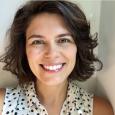“Let’s be scientists!” and “Are we ready to be engineers?” are common phrases heard in preschool and early elementary classrooms exploring STEM (Science, Technology, Engineering, Mathematics) projects and activities. These phrases which naturally flow off the tongue for many early childhood educators are said with the intention of helping young children connect and identify with the sciences. But what if these phrases actually have the opposite effect?
Beginning in pre-kindergarten, research has shown that subtle features of common language used by teachers (and other adults, like parents and caregivers) can interfere with – or facilitate – the development of children’s own engagement with science. Ahead of the upcoming NGCP webinar “Supporting Equitable Approaches to Early Science Education,” I had the pleasure of speaking with Amanda Cardarelli, a researcher at Education Development Center (EDC) who previously spent five years working at New York University (NYU) in a cognitive developmental research lab.
While at NYU, Cardarelli co-led a National Science Foundation-funded research initiative that investigated how the language used to teach science affects children’s engagement with science. The Conceptual Development and Social Cognition (CDSC) lab at NYU which Cardarelli was a part of, led by Dr. Marjorie Rhodes, explores how children learn and understand the world around them. The lab’s research focuses on the effects of language on shaping how children form categories of animals, objects, and people. Cardarelli shared with me the importance of language saying that “language is so powerful! Specifically, my research investigated how the language we use to introduce children to science affects science engagement.”
Cardarelli’s research suggests that just a subtle shift in how we introduce children to science can support young girls’ interest and persistence in science and can even expand their inclusivity beliefs about who can do science. She explains:
“Identity-focused language (e.g., “Let’s be scientists!”; “Scientists explore the world.”) is the most common way to introduce children to science. This identity-language primes children to think of the category of “scientist” which is stereotypically represented as White males. If children don’t think they fit in that exclusive category because of who they are, then they might withdraw from a lesson or activity if they encounter any sort of setback, because they don’t think they were meant to be a scientist to begin with. We found that replacing identity-focused language with action-focused language (e.g., “Let’s do science!”; “Let’s do science to explore the world.”) bolstered young girls’ interest in science and encouraged girls’ persistence in science after a setback.”
If you are an educator or caregiver working with young children, consider making a few shifts in the language you use when teaching STEM. Here are 3 simple suggestions from Cardarelli:
-
Use action-focused language – The biggest takeaway from Cardarelli’s research is the need to move away from solely using identity-focused language. “Using identity-language feels like a natural and engaging way to introduce kids to science, and this might be true for some children! However, if we want to encourage young girls in science, then introducing lessons and activities using action-language has proven to be more engaging across contexts and across time.”
-
Talk about science as a process – Educators should talk about science as an inclusive activity that anyone can engage with. Cardarelli explains that “educators and caregivers can focus on teaching children that science is a process that anyone can do, anywhere at any time.”
-
Encourage questions – A lot of focus is on what the educator is saying while facilitating STEM activities, but what about the kids? Cardarelli suggests fostering an atmosphere that prompts children to ask questions, make hypotheses, and celebrate mistakes as part of the learning process. “Encouraging children to do science by asking questions, making guesses, and testing out what might happen shows children that they can do science too.”
So, what are we waiting for? Let’s do science!
Supporting Equitable Approaches to Early Science Education Webinar
Want to learn more from Amanda Cardarelli? Register for the upcoming NGCP webinar “Supporting Equitable Approaches to Early Science Education” featuring Amanda Cardarelli. The webinar will be held on Thursday March 9th at 11am PT / 2pm ET.
